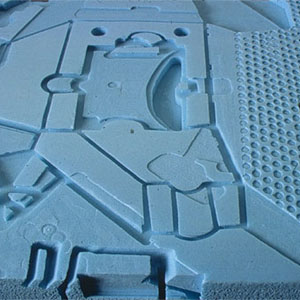BAC
VAI Nevada Neighbors Lectures
Karen Moss Essay
 |
| Shirley Tse Polymathicstyrene 1 (detail), 1999-2000 extruded polystyrene 17-3/4 x 50 x 3" |
Topographies:
A Look At Contemporary Visual Art in California
by Karen Moss
topography
1) the art or practice of graphic delineation in detail of natural and
man-made features of a place or region especially in a way to their relative
positions and elevation
2) the physical or natural features of an object or entity and their structural
relationships
In these traditional definitions from
Webster's Dictionary the word "topography" refers to the creation
of a metaphorical equivalent in words of a specific, physical landscape.
Most often the meaning of topography refers to the representation of a
landscape according to some conventional signs or systems of mapping (ie:
a topographic map.) With the permutation of language and its shifting
significance prevalent in post-modern thought of recent years, the idea
of topography as a singular, fixed entity has blurred into a realm of
multi-valent meanings of many topographies. The more limited definition
of topography used by cartographers and geographers may now be found in
diverse contexts ranging from art and architecture to medicine and metallurgy,
or realms of science and technology. The very concept of a singular definition
of topography, therefore, has evolved into multiple spatial configurations
and broken through boundaries of discrete disciplines.
This exhibition will present artists who work with the ideas about different
topographies or whose subject can be considered under the general rubric
of the "topographical." Less about the traditional genres of
landscape or cityscape, their representations are about specific localities
and/or senses of place. Including both natural and man-made subjects,
the rural and the urban, some topographical works refer to a location
in "real" space, while others are fictional. Traversing across
definitions and disciplines and media, artists are using divergent materials
and media to represent their various topographies, which range from the
literal to the conceptual. The artists all share an interest in some kind
of mapping, marking, siting, place-making, and an obsession with the aesthetics
of surface or space, which are often rendered in abstract, constructed,
imagined, invented, or even "hyperreal."
Their work ranges from more traditional and physical topographies related
to geography or cartography, to topographical mappings of cultural, social/psychological
spaces. Some are tangible and grounded in a precise location or space,
while others are fantasized, imagined or projected. Temporally, these
topographical expressions are memories of the things past, firmly anchored
in the present, or looking toward the future; the artists use time and
space to construct meaning for their own respective topographies.